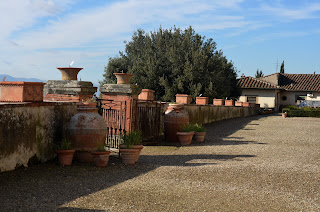La Petraia is a 15th century villa associated with the Medici family. You can visit the building which was decorated with 19th century taste when the king of Italy, Vittorio Emanuele II, lived in the villa.
There are two gardens at La Petraia, a green park behind the villa and a formal garden with parterres in front of the villa.
You could say that La Petraia is exactly the opposite of the Villa Balze garden (the last one I reviewed) which follows the modern concept of garden rooms.
At Villa Balze you go from one room to the next and find very different designs, plants and views in each room.
La Petraia is meant to bowl you over at one glance with its extent and magnificence. Like the Boboli, it is a garden that evokes man's total control over nature (in fact the control is never total as you can see in the gravel alleys on the right in the picture above, which are getting green with grass!)
It is not a flower garden, but instead an idealized landscape.
You might not be particularly fond of this kind of garden, but it is not without its points.
First and foremost is the fact that it can look just as good in January as in May.
Beside such gardens include all sorts of interesting "asides". One in La Petraia is this monster climbing rose that must be quite a sight when in bloom.
Another is this interesting edging for a bed. It is made of large clay leaves. I had never seen these.
Discovering in an iris bed needing weeding that Anemone coronaria is at times a weed in Italy is also a surprise!
I am always interested in the work areas as much as in the garden itself. Here is where some of the plants are started. The first pot had a sign saying "I am not an ashtray, but a pot planted with bulbs."
To the right is the limonàia which contains mostly hibiscus plants in pots.
The majority of these outside pots seemed to hold bulbs, but also Dianthus.
To me, the regularity and order of formal gardens produce a sense of stability and peacefulness, as illustrated in the following two pictures.
Behind the villa is a large park.
To end with, I could not resist this perfect example of thrift and of the principle "repair, reduce, reuse, recycle".
There are two gardens at La Petraia, a green park behind the villa and a formal garden with parterres in front of the villa.
You could say that La Petraia is exactly the opposite of the Villa Balze garden (the last one I reviewed) which follows the modern concept of garden rooms.
At Villa Balze you go from one room to the next and find very different designs, plants and views in each room.
La Petraia is meant to bowl you over at one glance with its extent and magnificence. Like the Boboli, it is a garden that evokes man's total control over nature (in fact the control is never total as you can see in the gravel alleys on the right in the picture above, which are getting green with grass!)
It is not a flower garden, but instead an idealized landscape.
You might not be particularly fond of this kind of garden, but it is not without its points.
First and foremost is the fact that it can look just as good in January as in May.
Beside such gardens include all sorts of interesting "asides". One in La Petraia is this monster climbing rose that must be quite a sight when in bloom.
Another is this interesting edging for a bed. It is made of large clay leaves. I had never seen these.
Discovering in an iris bed needing weeding that Anemone coronaria is at times a weed in Italy is also a surprise!
I am always interested in the work areas as much as in the garden itself. Here is where some of the plants are started. The first pot had a sign saying "I am not an ashtray, but a pot planted with bulbs."
To the right is the limonàia which contains mostly hibiscus plants in pots.
The majority of these outside pots seemed to hold bulbs, but also Dianthus.
To me, the regularity and order of formal gardens produce a sense of stability and peacefulness, as illustrated in the following two pictures.
Behind the villa is a large park.
To end with, I could not resist this perfect example of thrift and of the principle "repair, reduce, reuse, recycle".











Looks like you're having a very interesting time over there.
ReplyDeleteYes we visited this garden too. The English style of gardening is my favorite, but nevertheless I'm interested in other styles of gardening, the old Renaissance gardens in Italy have something special and indeed by the design they are nice all year round. Nice you show us last photo of the repaired pot. I think I cannot do that.
ReplyDeleteVery nice that they repair their clay pots - makes me feel like quite a wastrel.
ReplyDeleteThis garden looks familiar. Perhaps I have seen it in one of Monty Don's programs on Italian gardens? I am less fond of gardening that involves an " idealizing the landscape", than I am of a more informal style, but even so, it would be an absolute treat to see it.
ReplyDeleteI am not a great lover of formalised gardens but it is always interesting to view the layouts which often owe as much to architecture as the houses themselves giving them that year round appeal.
ReplyDelete